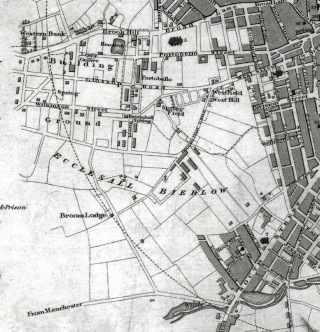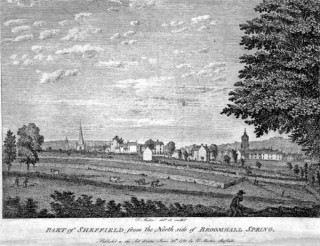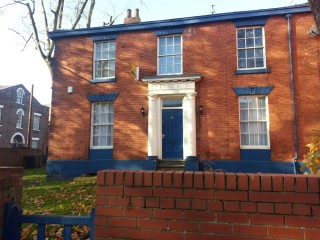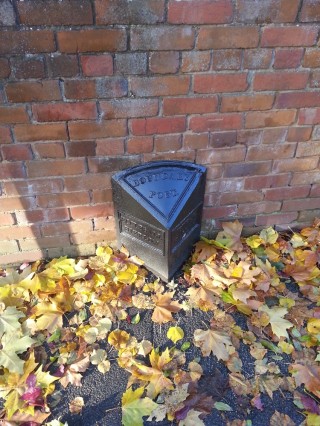Broomhall Spring
1791
Broomhall maps often show many springs in the area and indeed these are reflected in some of the local street names such as Broomspring Lane (formerly called Spring Lane) and the Springfield area. Springfield still survives today, namely in Springfield school and the Springfield estate. One local spring story however seems to have been lost in recent local knowledge is the area of ‘Broomhall Spring’. Evident on the Leather map from 1823 (see right) it was in the area of Gell Street and Conway Street.
Here are two accounts of Broomhall Spring.
Sketches
The Sheffield Independent newspaper on 22nd August 1885 reproduced the sketch of Sheffield seen here and a description:
“SHEFFIELD IN 1791, FROM THE NORTH SIDE OF BROOMHALL SPRIING:
We give to-day a reproduction from one of D. Martin’s Series of Sheffield Sketches, showing what was the appearance of the town from the north side of Broomhall Spring—that is to say, from what is now the lower part of Wilkinson Street—in 1791. Broomhall Spring was a wood of oak trees, extending from the present Wilkinson street to Broomhall Park, and in it, where now is the garden of the house at the corner of Gell street and Conway street, was the celebrated well, called in its latter days “Spring Garden Well,” and bearing the inscription, “Spring Garden Well. To the public use, by the Rev. James Wilkinson, and Phillip Gell, Esq. Freely take—freely communicate, thank God.” The intelligent reader will not fail to note that we have these reminiscence perpetuated in the names Broom Spring lane, Wilkinson street, and Gell street. The fields shown in our picture, intervening between Broomhall Spring and the Churches—the Parish Church, St. James, and St. Paul’s—are, we need hardly say, now occupied by the masses of brick that line what we know as West street, Division street and their adjacent thoroughfares.”
Reminiscences
Robert Eadon Leader’s book from 1876, ‘Reminiscences of Old Sheffield, its Streets and its People’ also gives an account of the area:
“Our old friend’s description of Broomhall Spring, which he remembered when he was about 10 years old — in 1791 — was very interesting. “I very well remember,” said he, “coming with my father through the wood called Broomhall Spring. It extended from about Wilkinson Street to Broomhall Park. It was full of very fine oak trees, with very little underwood, and the turf was soft like that of a park. I remember very well seeing the trees and the grass, and the sunlight gleaming among them. Not long afterwards the wood was cut down.The Government was then wanting a great deal of oak timber for ship-building, and the trees in Broomhall Spring were sold for that purpose.
The roots were dug up, and the land turned into the gardens of which we have been speaking.” The inscription on the stone over the trough was still there up to 1836. It ran : —
” Spring Garden Well. To the public use, by the Rev. James Wilkinson and Philip Gell, Esq. Freely take — freely communicate — thank God”. Its site is now enclosed in the garden of the house at the corner of Gell Sreet and Conway Street.”
The public well doesn’t appear to be in existence at this spot today. There is currently a parish boundary marker on the garden wall of this house but no sign of a well. Do leave a comment below if you know any more information about what happened to the well.













No Comments
Add a comment about this page